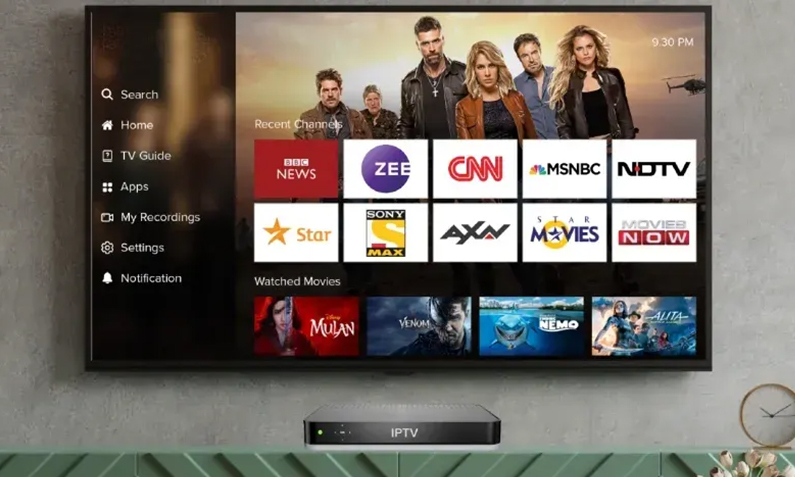What Is Internet Protocol Television ?
You’ve likely come across Internet Protocol Television (IPTV subscription) — a modern method of streaming live and on-demand video content directly through the Internet. By using advanced encoding techniques, IPTV efficiently compresses and delivers media to a wide range of devices, often through set-top boxes.

With the growing popularity of mobile devices, the IPTV market is expected to surpass $105 billion by 2029, offering flexible viewing options such as live IPTV, catch-up TV, Video on Demand (VoD), and customizable IPTV subscriptions. This fast-evolving technology continues to open new doors for digital entertainment, inviting deeper exploration into its innovations and potential.
Understanding IPTV subscription Basics
For decades, traditional broadcast methods have served as the foundation of television. However, Internet Protocol Television (IPTV subscription) marks a significant transformation in how content is delivered, leveraging Internet Protocol (IP) over managed networks.
This advanced technology enables the transmission of various media content — including Video on Demand (VoD) and live IPTV subscription— through broadband Internet connections. Its core infrastructure consists of multiple content sources that supply both live channels and on-demand videos. These streams are efficiently compressed through encoding systems and distributed via dedicated servers.
To enjoy this wide range of streaming services, users typically rely on set-top boxes or other compatible devices, ensuring a smooth and uninterrupted viewing experience.
How Does IPTV Work?
IPTV (Internet Protocol Television) is revolutionizing the way we experience entertainment by delivering television content through the Internet rather than traditional cable or satellite systems. Below is a simple breakdown of the key technologies and components that power IPTV subscription:
- IPTV management software improves the user experience by simplifying the process of browsing, selecting, and streaming content.
- Internet-based delivery replaces conventional broadcast methods, supporting both live TV channels and on-demand content.
- Advanced codecs compress media files for efficient transmission over managed networks, enabling fast and reliable streaming.
- Set-top boxes and compatible smart devices connect viewers to streaming servers, providing instant access to diverse programming.
- Flexible viewing options, such as Live IPTV subscriptionand Video on Demand (VoD), give users greater control over what and when they watch.
- A stable, high-speed Internet connection remains essential for smooth playback and optimal video quality.
Different Types of IPTV Services
Building on the technological foundation of IPTV, it’s essential to explore the different types of IPTV subscription services that shape the user experience.
IPTV services generally fall into three main categories, each offering distinct viewing options:
- Live IPTV: This service delivers real-time broadcasts of television channels, perfect for viewers who enjoy watching events as they happen — much like traditional TV.
- Time-Shifted IPTV: Also known as catch-up TV, this option allows users to watch previously aired programs, offering the flexibility to view missed content at their convenience.
- Video on Demand (VoD): This feature provides access to a vast library of on-demand videos, giving users complete control over what and when they watch.
Most subscription-based IPTV services combine these features into one integrated platform, offering a seamless blend of live streaming, time-shifted viewing, and on-demand entertainment — all designed to suit diverse viewing preferences.
The Future of IPTV and Emerging Trends
The IPTV subscription market is on a strong growth path, projected to exceed $105 billion by 2029, driven by rapid digitalization and the widespread adoption of mobile devices.
As viewing habits continue to evolve, subscription-based IPTV services are expected to dominate, reflecting the growing demand for flexible, on-demand entertainment options. Meanwhile, hybrid IPTV solutions are emerging to bridge the gap between traditional broadcasting and IP-based delivery, offering a smoother transition for users.
Additionally, Live IPTV subscription and catch-up TV are poised to become mainstream, fueled by audiences’ increasing appetite for real-time and time-shifted viewing experiences.
Key Market Highlights:
- Market Growth: IPTV revenues projected to surpass $105 billion by 2029.
- Subscription Services: Rising consumer preference for on-demand content.
- Hybrid IPTV Solutions: Seamless integration of traditional and IP-based platforms.
- Live & Catch-Up TV: Growing popularity of real-time and flexible viewing options.
Frequently Asked Questions
How Does Internet Protocol TV Work?
IPTV technology depends on advanced video compression and robust network infrastructure to deliver high-quality streaming and reliable content transmission. The overall user experience is influenced by factors such as device compatibility, channel availability, and the chosen subscription model. Looking ahead, emerging technological trends are expected to further enhance IPTV’s efficiency, accessibility, and overall performance, making it an even more seamless and engaging viewing platform.
What Does IP Mean on TV Channels?
When you encounter the term “IP” on television channels, it refers to Internet Protocol Television (IPTV) — a system that delivers TV content via the Internet. IPTV offers key advantages such as flexibility, interactivity, and access across multiple devices. However, its performance is largely dependent on Internet quality, which can affect streaming stability.
To meet diverse viewing needs, IPTV providers offer subscription-based plans that enable seamless streaming on various devices, powered by advanced IPTV technologies and enhanced user features
Is IPTV Worth Paying For?
When you encounter the term “IP” on television channels, it refers to Internet Protocol Television (IPTV) — a system that delivers TV content via the Internet. IPTV offers key advantages such as flexibility, interactivity, and access across multiple devices. However, its performance is largely dependent on Internet quality, which can affect streaming stability.
To meet diverse viewing needs, IPTV providers offer subscription-based plans that enable seamless streaming on various devices, powered by advanced IPTV technologies and enhanced user features.
